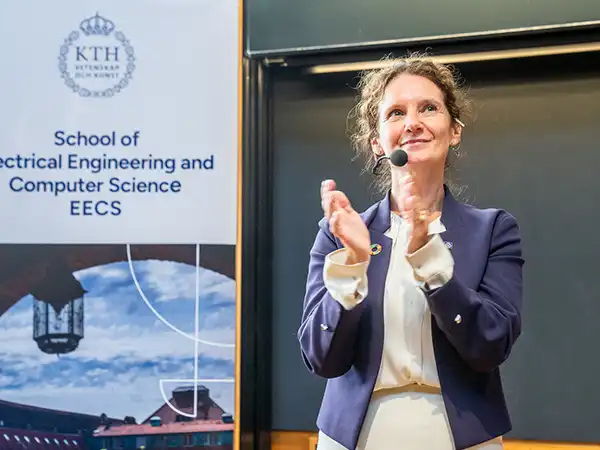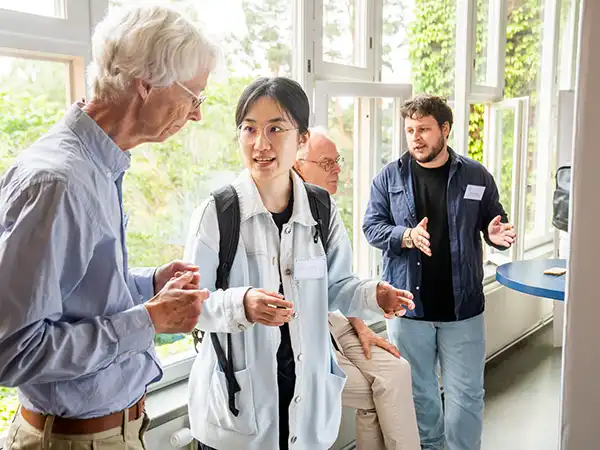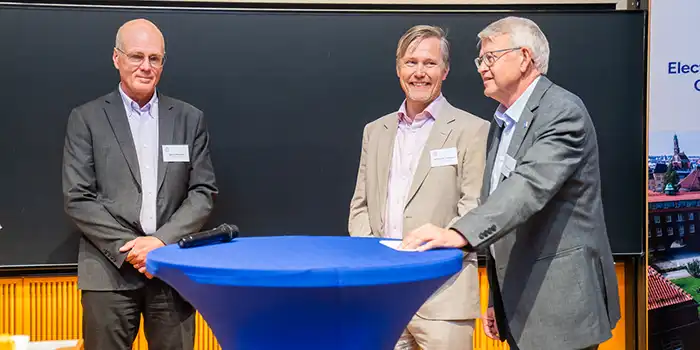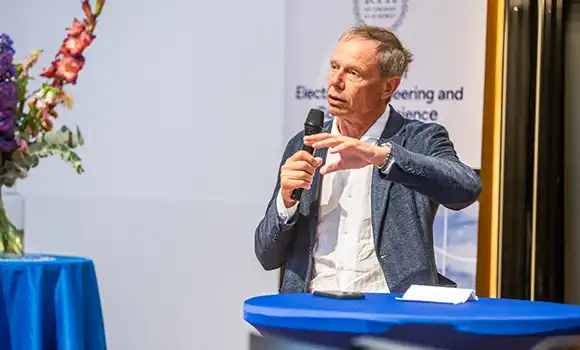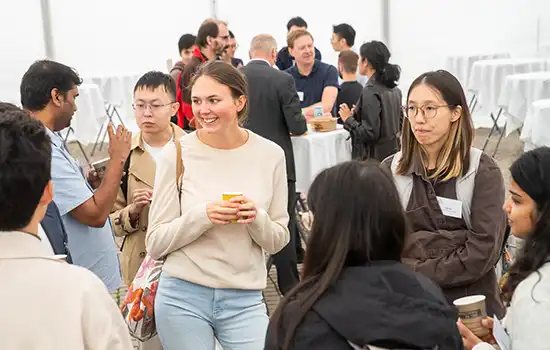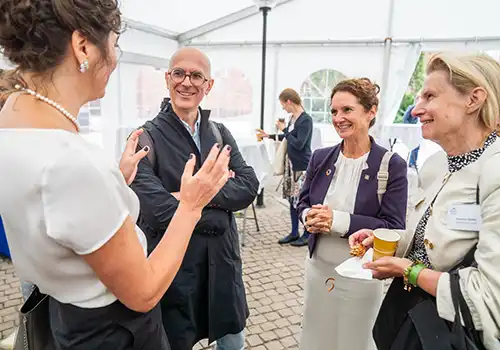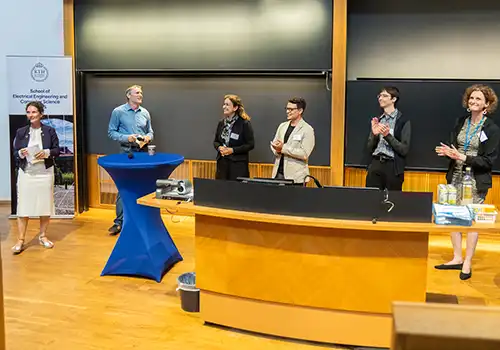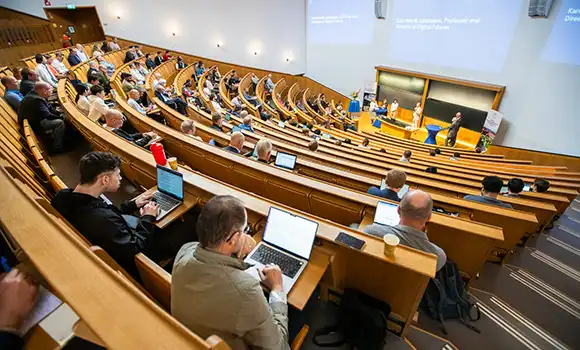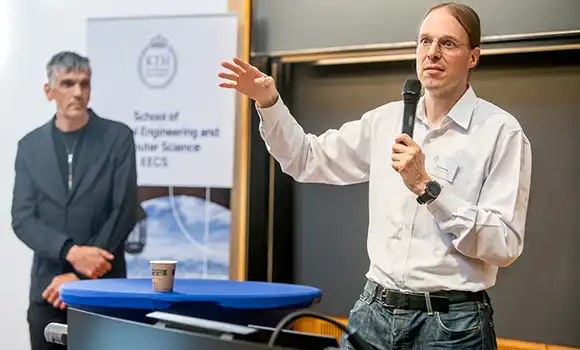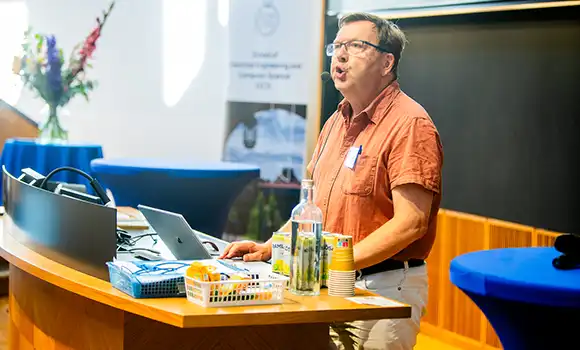EECS's Research & Impact Day highlights progress behind our digital future
For the second year in a row, the autumn semester began with EECS Research & Impact Day. This year, the focus was on new perspectives on research and development in a digital future. The topics ranged from cyber security, plasma physics and the next generation of mobile networks (6G), to generative AI and space travel.
The aim of the EECS Research & Impact Day is to present current research that can inspire new ideas and collaborations. It also provides EECS school staff the opportunity to meet and learn more about each other's areas of expertise. The half-day event began with a joint networking lunch and poster exhibition.
Lina Bertling Tjernberg, the school’s deputy head of school with a focus on research conditions and impact, is the driving force behind the event. She welcomed the nearly 200 participants together with Ann Lantz, head of EECS school.
“Research & Impact Day is a day when we can meet and get to know each other better, talk about our research, and share exciting results. It's an inspiring day for new collaborations, and this year's theme is digital futures,” says Bertling Tjernberg, professor in power grid technology.
She began the day presenting EECS’ strategic funding programme Small and Visionary Projects. It offers EECS employees the opportunity to apply for funding up to SEK 500,000 for collaborations on new project applications.
Outlook on Research and Science with Digital Futures
Afterwards, Research & Impact Day hosted four panel presentations, where 20 researchers and experts provided insights into their respective fields and research environments. Several external participants also took part, including Katarina Bjelke, director general of the Swedish Research Council, who opened the first panel.
Bjelke provided a broad overview of the role of the Swedish Research Council play in supporting and funding research and development to strengthen digital development. Bjelke emphasised the need for well-organised and collaborative initiatives to create new research breakthroughs.
She described the Council's initiatives in its development of four collaborative pillars:
- Strengthening computer resources and AI capacity
- Increasing access to high-quality research data and infrastructures such as SciLifeLab, MAX IV and ESS
- More secure data transfer systems
- Strong user support for researchers
“Through coordinated initiatives, funding can promote scientific breakthroughs and strengthen the societal benefits of research,” she said.
Next up was Monica Billger, director of InfraVis, a national infrastructure for data visualization. She demonstrated how InfraVis can help researchers better understand and disseminate their results. Through various visualisation methods, large amounts of data can be made easier to understand and to use. InfraVis can contribute to all areas of research, she emphasised, while also increase the understanding of data combined from different research areas.
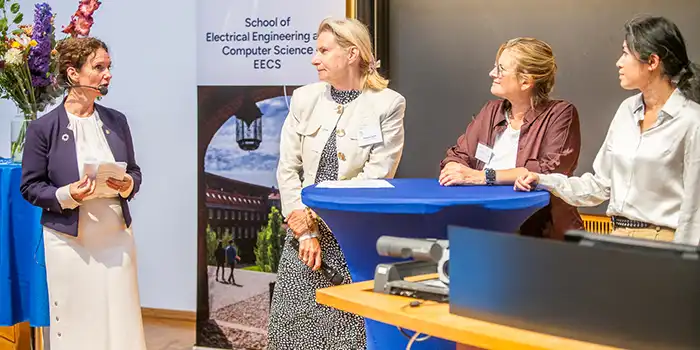
The initiative is supported by nine universities and has eight different nodes across the country, including one at KTH. InfraVis works actively to reach out to researchers, offering users of the Max IV research infrastructure help in visualising their results. The support is available already at the point of applying for time at the facility.
The next panel participant was Hanifeh Khayyeri, vice president in computer science at RISE Research Institutes of Sweden and external member of the EECS school's faculty board. Khayyeri emphasised the benefits of the education and research carried out at EECS and their contributions to social development. In particular, she highlighted the importance of good education, which is sometimes overshadowed by research, she said. Khayyeri praised EECS for being at the forefront of research in power electronics, electronics, telecommunications, AI, and high-performance computing. KTH plays a central role in societal development by combining cutting-edge research with the long-term societal benefits of education.
Khayyeri was followed by Björn Ottersten, professor at both KTH and the University of Luxembourg. He heads the Interdisciplinary Centre for Security, Reliability and Trust at the University of Luxembourg. Since 2012, Ottersten has been an advisor to the European Commission and a member of the Scientific Council at the European Research Council (ERC). Ottersten emphasised the importance of international recruitment when building a strong research environment. It is also important to prioritise research initiatives in order to achieve a strong impact. He stressed that close collaboration with society and political actors is also necessary for success. Ottersten also highlighted the new ERC+ research programme which will be launched in 2026. This could be an important step towards increasing the ERC's research budget with the aim of further strengthening Europe's competitiveness.

The next presentation was given by Karl Henrik Johansson, professor at the Division of Decision and Control Systems and director of KTH's Digital Futures research centre. Johansson started off by asking the audience to raise their hands if they in any way were involved with the research centre. It turned out that almost half of them were involved with Digital Futures in some way, in practice KTH's largest research centre.
Johansson emphasised the importance of interdisciplinary research and collaboration between universities, industry and the public sector. He highlighted in particular a new project that aims to transform Stockholm into a digital ‘sandbox’ for interdisciplinary research and development. He also discussed the efforts to increase the links between KTH's research groups and KTH Innovation in order to boost the number of spin-off companies from research.
The last speaker of the first panel was professor Mikael Östling, a former vice-chancellor of KTH. He began by congratulating Digital Futures on its successes, which were established during Östling's time as vice-chancellor.
Östling also emphasised the importance of developing new materials in order to continue building new successful digital solutions. He called for more initiatives to increase awareness of what new materials can mean for the development of information systems, architectures and security solutions - preferably in the form of interdisciplinary collaboration between universities.
“Sweden already has strong educational programmes with close ties to industry,” he said.
“By broadening our perspective from programming to new materials, we can work together to build more strong companies.”
Space Mission Data and Plasma Physics with High Performance Computing
The second panel of the day was opened by Christer Fuglesang, professor of space technology and director of the KTH Space Centre. He offered several examples of how years of space travel have led to improvements in our society.
Several projects, among them at KTH, are currently underway to reduce the amount of information sent from satellites to Earth. Through the use of AI, it allows the satellites to evaluate and analyse data themselves. Complementary projects aim to provide satellites with a more robust energy supply, including the use of nuclear energy.
Fuglesang also highlighted the development of KTH's Space Robotics Laboratory, where researchers from several different schools can collaborate.
Fuglesang was followed by Tomas Karlsson, professor of space plasma physics. He spoke about his and KTH's participation in both small-scale and large international space projects. Among the large-scale projects are the European-Japanese BepiColombo mission to Mercury, NASA's Magnetospheric Multiscale mission, ESA/JAXA Bepi Colombo, and ESA's upcoming mission to Jupiter.
The goal is to provide a better understanding of the environments around Earth and other planets affect them. The experiments generate enormous amounts of data. To analyse them researchers are using AI in their quest to develop and organize new methods for organising and classifying the information.
“Ideally, this work should be done on board the spacecraft,” Karlsson said.
Svetlana Ratynskaia, professor in plasma physics, provided an insight into the development of the international research reactor ITER. It is an attempt to recreate some of the sun's nuclear reactions on Earth. To succeed, methods for digitally modelling the reactor are required, several of which are being developed at KTH.
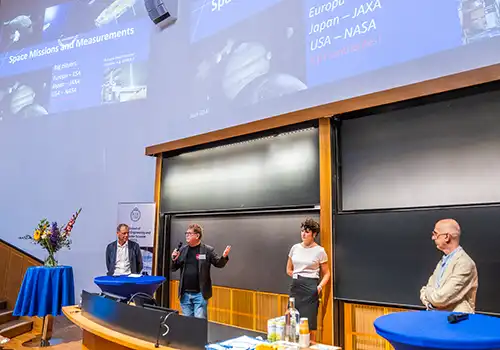
Ratynskaia was followed by Stefano Markidis, professor in computer science, who specialises in high-performance computer systems such as supercomputers and quantum computers. A research centre at KTH is developing methods for modelling fusion reactors such as ITER where the plasma in the reactor is kept in place by magnetic fields. This requires a deeper understanding of the physics behind the reactions and new ways of making the models work on some of the world's most powerful supercomputers. Markidis also presented projects that may improve simulations on weather in space, which have a direct impact on communications on Earth.
In a closing argument from the panel, several participants pointed out that technology developed for use in space also has a strong impact on society. Instead of thinking of space as something distant, we should acknowledge how we are all part of it.
AI for Scientific Discovery and Engineering and Society from 6G to Generative AI
Following a break for group photos and an opportunity for networking and mingling among the participants, the next panel took to the stage under the theme ‘AI for Scientific Discovery and Engineering and Society from 6G to Generative AI’.
The panel was opened by Alexandre Proutiere, professor of electrical engineering and director of the KTH Centre for AI. The research initiative brings together AI researchers from across KTH. It applies an interdisciplinary approach in order to spearhead the next generation of AI methods and applications. Diverse fields such as mathematics, computer science, robotics and control engineering are brought together to strengthen AI development but also to contribute to new breakthroughs in physics, mathematics, natural sciences and life sciences.
The KTH Centre for AI was established in early 2025 and is developing into a hub for partnerships and networks across Europe.
Next up was Cicek Cavdar, recently appointed professor in communication systems. As part of the new multidisciplinary research centre MRC – 6G Satellite Communication (6GSAT), Cavdar presented the latest on the next communication network, 6G. New solutions are being developed that can use existing satellites as part of the next generation of mobile networks. The goal is to cover even the most remote parts of the world. The road to tomorrow's communication methods requires more energy-efficient systems and new AI algorithms.
The next panel participant was associate professor Paris Carbone, a researcher and lecturer in computer systems recently named Teacher of the Year at KTH. He spoke about his work in distributed systems and his hope that AI can be used to automate systems via new frameworks. He also highlighted the rapid development of AI agents for collecting and presenting information in ways that could completely replace today's internet searches.
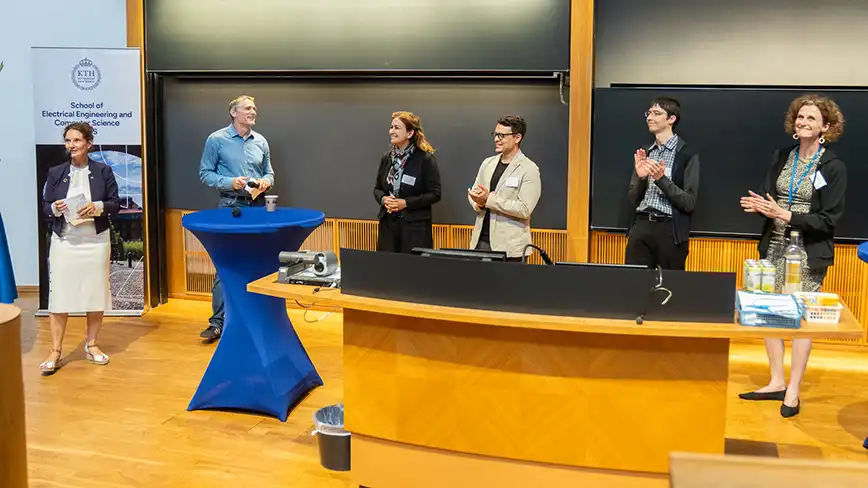
Carbone was followed by Thomas Winkler, a researcher in micro- and nanosystems. He provided insight into the development of the IMPreT (In vitro Models for Precision Therapies) research initiative. Through IMPreT, world-leading experts at KTH are developing advanced human in vitro models, such as organoids and organ-on-chip. The goal is to strengthen the development of drugs and precision medicine, primarily in cancer, by creating a new research hub in Sweden. AI plays a central role in managing the enormous amounts of data generated. It contributes to the design of cell environments and flow chambers, among other things. AI is used both as a tool and as a kind of development partner for new biotechnological platforms.
Hedvig Kjellström, professor in the division of Robotics, Perception and Learning at KTH, then presented the GAME research initiative which focuses on broadening the use of generative AI. GAME’s research ranges from modelling turbulent flows to simulating chemical and biological processes. An important part of driving the development forward is to strengthen national collaboration using Sweden’s high-performance computing resources. The initiative, which has close links to the KTH Centre for AI, aims to build a platform where different branches of research can benefit from each other's progress.
Cyber Security and Privacy and Safety Critical Systems
The final panel at this year's Research & Impact Day was entitled ‘Cyber Security and Privacy and Safety Critical Systems’. Just like last year, part of the focus was on cyber security, including a presentation of Cybercampus Sweden - a national initiative to strengthen Sweden's cyber defence.
Mathias Ekstedt, professor in industrial information and control systems, provided an overview of cyber security research conducted at KTH. A key initiative in this research is CDIS, the Centre for Cyber Defence and Information Security, which is conducted in collaboration with the Swedish Armed Forces. For almost a decade, KTH has also been running a highly regarded summer school in cyber security.
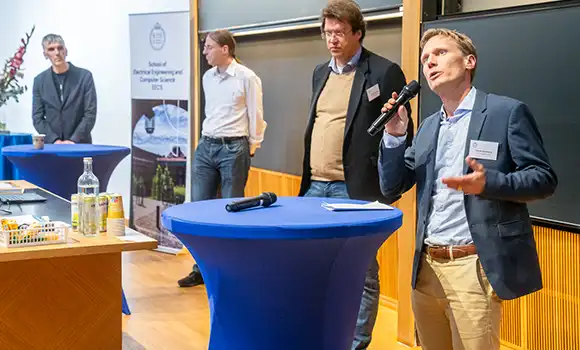
Technical research encompasses everything from data security, software security and cryptography to security in hardware, communication networks and large IT systems. However, Ekstedt also stressed the human, organizational and societal aspects of the field. Furthermore, he presented his own research on how ‘attack simulations’ help organisations manage and strengthen their cyber security.
Eksted was followed by associated professor Cyrille Artho, a lecturer in theoretical computer science. He presented research aimed at increasing the reliability of complex software. Today's software consists of hundreds of millions of lines of code and is therefore impossible to check manually. However, by creating new forms of controls, it should be possible to provide better guarantees that systems behave as expected. The controls should also be visible and verifiable to users, for example when handling sensitive data in health apps or during bank transactions.
Artho emphasised the need for global collaboration on the issue, particularly with emerging economies, to ensure a safer digital future for all.
Next up was Tobias Oechtering, a professor of communication theory specialising in collaborative communication. He highlighted personal privacy as one of the biggest challenges in a data-driven society.
“Today, we share our data without understanding the long-term consequences,” Oechtering said.
While GDPR provides strong protection, the legislation also slows down innovation. New technical and theoretical solutions can provide better alternatives than today's rules and standards, all with the aim of creating models that both protect individual data and enable technological development.
The last panel participant was Henrik Sandberg, professor at the Division of Decision and Control Systems, with a focus on large-scale control systems. He presented research aimed at strengthening, for example, drones' defence against cyber attacks. Extremely time-critical systems require new ways of managing cyber security. This include the use of AI. Researchers at KTH use test beds to simulate attacks by manipulating position data or creating time delays. The goal is to develop methods that can secure future autonomous systems against targeted cyber threats.
After the panel presentations, Sten Ternström, professor in music acoustics, took the stage for an enjoyable and entertaining presentation on the field of speech, music and hearing. Using recorded sounds but above all his own voice, he demonstrated the possibilities available through what is known as the ‘acoustics of the voice’.
EECS Research & Impact Day wrapped up with an award ceremony for the best poster of the day. The winner was Parag Khanna’s poster ‘Adapting robotic explanations for robotic failures in human-robot collaboration’. The awarding prize jury consisted of Olle Bälter, Saikat Chatterjee and Jörg Conradt.


